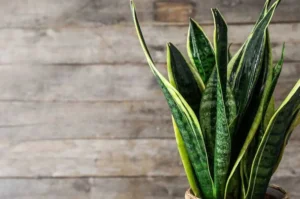The snake plant, formally identified as Sansevieria trifasciata, is widely known for its striking upright leaves and reputation as an easy-to-care-for houseplant. Among its many names, one stands out for its humor and cultural reference: “Mother-in-law’s tongue.” At first glance, this nickname may seem odd or even humorous, but it has interesting origins rooted in symbolism, appearance, and tradition. This article explores why the snake plant earned this name, what characteristics contributed to it, and how people across cultures perceive it.
What Is a Snake Plant?
Originally native to parts of West Africa, the snake plant is a tough, perennial succulent with long, sword-shaped leaves that grow vertically. These leaves often display green bands and yellow margins, giving them a distinct and decorative look.
Its hardy nature makes it incredibly popular among plant lovers. Snake plants require little water, can tolerate poor lighting, and rarely suffer from pests, making them perfect for busy lifestyles and indoor environments. They also contribute to better indoor air quality by filtering out pollutants.
The Story Behind the Name “Mother-in-Law’s Tongue”
The nickname “mother-in-law’s tongue” was coined because of the sharp, rigid, and pointed leaves of the plant, which people humorously compared to the stereotypical sharpness of a mother-in-law’s words. It plays off an old trope used in jokes, where mothers-in-law are portrayed as critical or outspoken.
Why This Name Makes Sense:
- Leaf Shape: The leaves resemble long, pointed tongues, which ties directly into the name.
- Stiff Texture: The rigid, blade-like structure symbolizes a metaphorical “sharp tongue.”
- Cultural Humor: In some Western traditions, mild jokes about in-laws are common, and the name reflects this playful tone rather than any real insult.
Though it may sound cheeky today, it’s meant to be humorous and memorable, not disrespectful.
Cultural and Symbolic Meanings
The snake plant is more than just a decorative houseplant; it holds various symbolic meanings across different cultures.
- In African traditions, this plant is associated with protection and resilience. It is believed to offer spiritual safeguarding and is often placed at entry points to ward off negative energy.
- In Chinese Feng Shui, the plant is used to attract protective chi and is strategically placed to absorb harmful energy.
- In Western cultures, the plant’s nickname is mostly used humorously, often without deep thought about its origin.
Interestingly, in all these contexts, the plant represents strength, endurance, and purification, regardless of its nickname.
Key Features That May Explain the Name
Certain characteristics of the snake plant lend themselves to the nickname “mother-in-law’s tongue”:
- Blade-like Leaves: Each leaf is long and ends in a sharp tip, resembling a sword or tongue.
- Vertical Growth Pattern: The upright stance of the leaves gives them a vocal or expressive appearance, almost like they’re speaking.
- No-Nonsense Resilience: Just like the stereotype it’s named after, the plant can withstand neglect and tough environments, refusing to give up easily.
The name may sound humorous, but it’s rooted in how the plant looks and behaves: sharp, enduring, and noticeable.
Why People Love the Snake Plant
Despite the playful nickname, the snake plant is appreciated worldwide for its many benefits:
- Air Purifier: Studies by NASA have shown that it filters out harmful toxins like formaldehyde and benzene, improving indoor air quality.
- Low-Maintenance: It can go for weeks without water and does well in low-light conditions.
- Visually Unique: Its bold structure and patterned leaves make it a standout decorative plant.
- Oxygen Release at Night: Unlike most plants, the snake plant releases oxygen during the night, making it a great addition to bedrooms.
These qualities have made it a staple in homes, offices, and public places alike.
Frequently Asked Questions (FAQs)
Is the nickname "mother-in-law’s tongue" offensive?
Not usually. It’s generally taken as a light-hearted term based on old-fashioned humor. Most people use it affectionately or jokingly, not in a hurtful way.
Does the snake plant have other names?
Yes. It is also called viper’s bowstring hemp, due to its fibrous leaves, and Sansevieria. Botanically, it’s now classified under the Dracaena genus.
Conclusion
The nickname “mother-in-law’s tongue” may raise a few eyebrows, but it’s actually a nod to the plant’s strong features and upright presence. Whether seen as a humorous label or a cultural metaphor, the name highlights the uniqueness of this plant in a memorable way.
Beyond its name, the snake plant remains a favorite for its durability, beauty, and health benefits. It’s a true survivor, just like the stereotype it’s nicknamed after. No matter what you choose to call it, the snake plant is a smart and stylish choice for any space.






